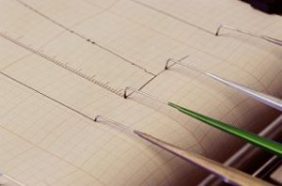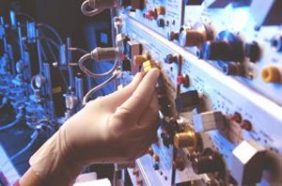Electricity’s spark of life
Researchers are taking advantage of the vital roles that electricity plays in our bodies to advance medicine.

Electricity has the power to animate our bodies — and maybe to advance medicine.
Trifonov_Evgeniy/iStock/Getty Images Plus
By Emily Sohn
Lots of kids get scared when their bedroom lights go out at night. When an entire city goes dark, many more people start to worry.
Government and utility officials are still scrambling to explain a blackout that hit much of the northeastern United States in late summer. From Detroit to New York, lights went out. Refrigerators, traffic signals, elevators, and subway trains stopped working. Computers went dead.
Without electricity, people had trouble getting to work, shopping for groceries, and communicating with each other. Normal life pretty much shut down for a few days.
Electricity also plays a crucial role within the human body. A lightning bolt or shock can disrupt or shut down that flow, causing disability or death.
“Electricity is life,” says David Rhees. He’s the executive director of the Bakken Library and Museum in Minneapolis. It is dedicated entirely to the history and applications of electricity and magnetism in biology and medicine.
The museum has a lot to keep up with. As scientists learn more about the electrical signals that whiz through our bodies and the electrical pulses that tell our hearts to beat, they are finding new ways to use electricity to save lives.
Research on the nervous systems of animals and people are helping scientists design machines that help diagnose and treat brain conditions and other problems. New drugs are being developed to regulate the body’s electrical pulses when injury or disease makes things go wrong.
Electricity everywhere
Electricity is everywhere, thanks to the unique structure of our universe. Matter, which is basically everything you see and touch, is made up of tiny units called atoms. Atoms themselves are made up of even tinier parts called protons and neutrons. Those tiny particles form the atom’s core. Orbiting outside that core are an atom’s electrons.
Protons have a positive electrical charge. Electrons have a negative charge. Normally, an atom has an equal number of electrons and protons. Their positive and negative charges cancel each other out. That leaves the atom electrically neutral.
When an atom gains an extra electron, it becomes negatively charged. When an atom loses an electron, it becomes positively charged. When conditions are right, such charge imbalances can generate a current of electrons. This flow of electrons (or electrically charged particles) is what we call electricity.
The first person to discover that electricity plays a role in animals was Luigi Galvani. He lived in Italy in the late 18th century. Electricity can cause a dissected frog’s leg to twitch, he found. This showed a connection between electrical currents traveling along an animal’s nerves and the action of muscles.
Quick signals
All animals that move have electricity in their bodies, notes Rodolfo Llinas. He’s a neuroscientist at New York University’s School of Medicine. Everything we see, hear, and touch gets translated into electrical signals that move between the brain and the body. They travel along special nerve cells called neurons.
Electricity is the only thing that’s fast enough to carry the messages that make us who we are, Llinas says. “Our thoughts, our ability to move, see, dream, all of that is fundamentally driven and organized by electrical pulses,” he says. “It’s almost like what happens in a computer but far more beautiful and complicated.”
By attaching wires to the outside of the body, doctors can monitor the electrical activity inside. One special machine records the heart’s electrical activity to produce an electrocardiogram (EKG) — strings of squiggles that show what the heart is doing. Another machine produces a pattern of squiggles (called an EEG) that represents the electrical activity of neurons in the brain.
 |
|
This recording of brain waves, called an EEG, represents the electrical activity of neurons in the brain.
|
One of the newest technologies, called MEG, goes even further. Instead of just squiggles, it produces maps of magnetic fields caused by electrical activity in the brain.
Recent observations of patterns of nerve-cell action have given scientists a much better view of how electricity works in the body, Llinas says. “The difference between now and 20 years ago is not even astronomical,” he says. “It’s galactic!”
Now, researchers are looking for new ways to use electricity to help people with spinal injuries or disorders of the nervous system, such as Parkinson’s disease, Alzheimer’s disease, or epilepsy.
People with Parkinson’s disease, for example, often end up having tremors and being unable to move. One type of treatment involves drugs that change the way nerve cells communicate with each other. As part of another new treatment, doctors put tiny wires on the head that send electrical impulses into the patient’s brain. “As soon as you put that in,” Llinas says, “the person can move again.”
Philip Kennedy works at Emory University in Atlanta. He has invented a kind of “thought control” to help severely paralyzed people communicate with the outside world. His invention, called a neurotrophic (NUUR-oh-TROW-fik) electrode, is a hollow glass cone filled with wires and chemicals. With an implanted electrode, a patient who can’t move at all still can control the movement of a cursor across a computer screen.
Looking to the past
One way to help keep the medical field speeding into the future might be to cultivate an appreciation for the past. At least, that’s what the folks at the Bakken museum think.
 |
|
Modern-day medical equipment powered by electricity.
|
I recently visited the museum. There, Rhees and Kathleen Klehr, the museum’s public relations manager, took me down to a huge padlocked room in the basement. This room is called “The Vault.” Row upon row of its shelves were crammed with rare, old books about electricity. There were also early versions of pacemakers and hearing aids, and all sorts of weird devices. One was a shoe-store X-ray machine, powered by electricity. It could show you whether your foot fit comfortably into a new shoe.
Upstairs, the exhibits included a tank of electric fish and Hopi dolls dedicated to the spirit of lightning.
There’s also a whole room dedicated to a monster made famous in a book titled Frankenstein. Made from assorted human parts, the monster was brought to life by an electrical spark. When Mary Shelley wrote Frankenstein in 1818, electricity was still a relatively new idea, and people were fascinated by the possibilities of what they might be able to do with it.
Even today, the Frankenstein room, with its scary multimedia presentation, remains one of the Bakken’s most popular exhibits, Klehr told me. “It’s been centuries,” she says, “and everyone is still excited about Frankenstein.”
That’s something you might keep in mind the next time a blackout strikes. Without electricity, those monsters under your bed might have a lot less power over you!
Going Deeper:







